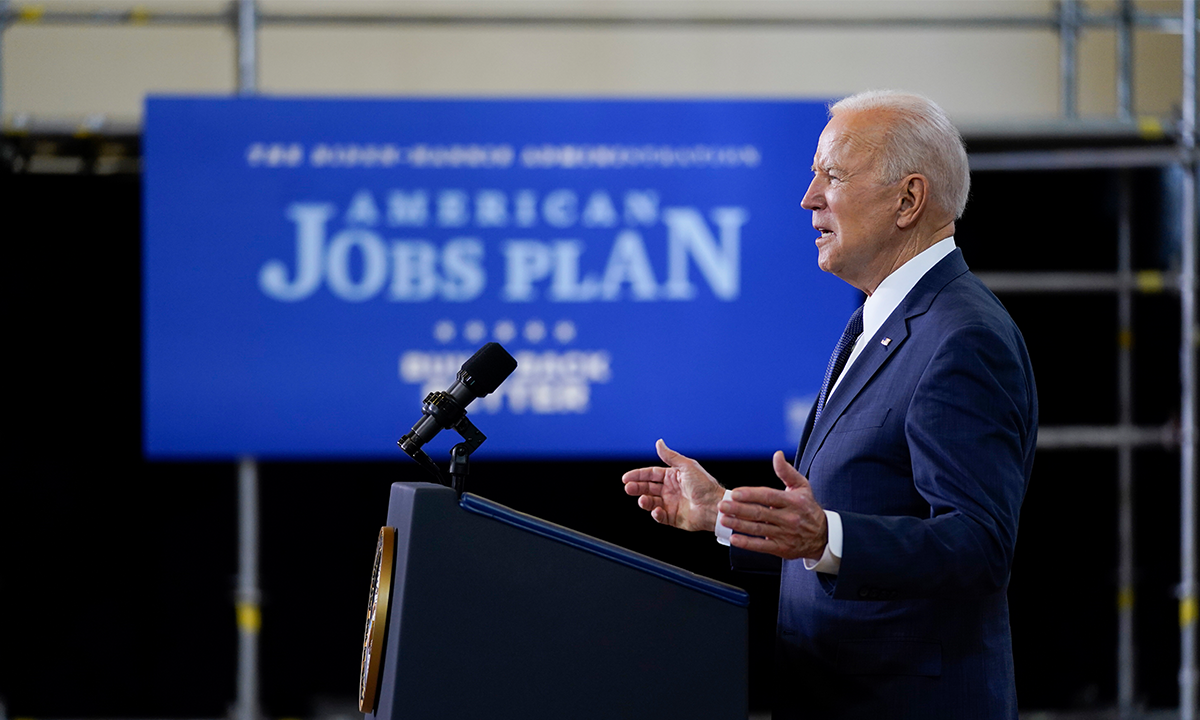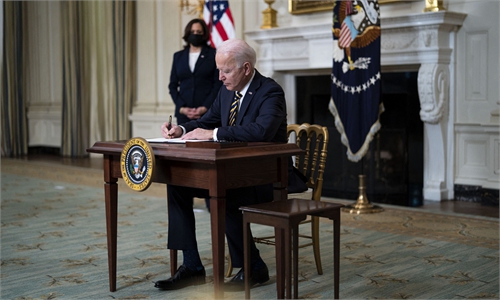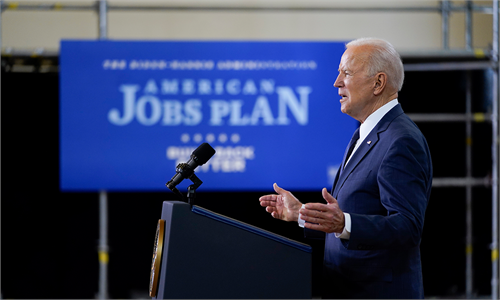Biden’s infrastructure plan may feel pain from US-China decoupling

US President Joe Biden delivers a speech on a $2 trillion infrastructure spending at Carpenters Pittsburgh Training Center on Wednesday in Pittsburgh. Photo: VCG
US President Joe Biden wants to spend $2.3 trillion on infrastructure, a move that is obviously stimulated by the "rival" China. But when massive construction work in the US begins, the Americans might feel the pain of "political decoupling" with China.A Chinese saying goes: "Any problem that money can fix is not a problem." I wonder if he knows it. Unfortunately, it is not a good time now for infrastructure development in the US.
The No.1 problem Biden faces is: a lack of construction workers. A Yahoo news video from last year showed that the 2008 financial crisis cost the US construction industry 1.5 million jobs. By mid-2020 when the industry started to recover, there was still a labor shortage of 350,000. The key is having skilled workers, which the US now lacks. One reason is that fewer young people are willing to do the work. With a median annual wage of $34,810, the construction industry is arguably unattractive.
This video also notes more construction industry problems, such as lack of construction materials. Many primary and auxiliary materials are no longer produced in the US, or only produced in small quantities with higher prices.
If President Biden wants to learn some lessons from its "rival" China on this matter, the first thing is that the advancement of large-scale national infrastructure projects requires strong government decision-making, execution, coordination and communication and the capability to deploy companies.
A 2017 survey taken in the US regarding infrastructure project delays showed that there were four main problems. The first was the communication process. The second was the decision-making process. The third was the design process, including design errors, and the fourth one was the operator's efficiency, including lack of skilled workers. All the four reasons were related to the government and its governance system if national or government projects are to be taken.
Besides, infrastructure projects also need a lot of steel and iron. About 30 percent of steel in the US needs to be imported from abroad. The US Department of Commerce hopes to increase the self-sufficiency rate of steel and iron from 70 percent to 80 percent, but this goal isn't easy to achieve in the short term. Whereas former president Donald Trump imposed tariffs on imports of steel and aluminum to the US, the price of construction materials increased significantly.
This reflects a more troubling issue: the US is in the process of de-industrialization as it starts to engage in large-scale infrastructure.
In China, the large-scale investment in infrastructure took place in the middle of the industrialization process. The country was able to accelerate the process of infrastructure due to the two factors complement each other.
The US now wants to expand infrastructure while many related factories have already been relocated or closed. You can imagine the difficulty.
There is also more telling data: only about 15 percent of current US capital from financial institutions goes to the real economy and business investment. In the early 20th century, banks would invest most of the money in real economy or business investment.
Without investing in related manufacturing sectors, Biden's ambitious infrastructure plan won't see desired results even with a huge investment.
Of course, there is an option. Perhaps more imports of "Made in China" could help remedy it. But I do not know whether the Biden administration is willing to do so.
After the US finishes infrastructure upgrade, including internet networks, American households may need to upgrade relevant electrical appliance, which are inseparable from Made-in-China products, even if they are foreign brands. From Obama to Trump and now Biden, the slogan of revitalizing American manufacturing has been repeated. But there are few results. This is simply because of the law of economic operation. Trump has not bucked the law. His wealth was mainly dependent on careful calculation. His construction company was largely reliant on Chinese manufacturing products that were competitively priced.
According to a 2016 report in Business Week, Trump imported steel and aluminum from China for at least two of his last three construction projects before entering the presidential race.
One of his projects in Chicago purchased a large amount of energy-efficient glass walls from China. That alone cost American companies an estimated order of more than $350 million at US market prices. Trump made money by saving money, and, crucially, the quality of the construction did not deteriorate as a result.
The author is a senior editor with People's Daily, and currently a senior fellow with the Chongyang Institute for Financial Studies at Renmin University of China. dinggang@globaltimes.com.cn. Follow him on Twitter @dinggangchina




